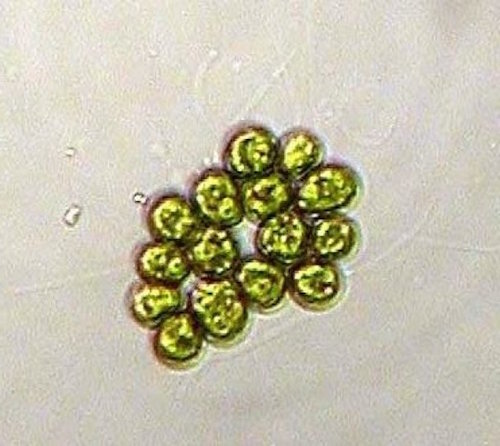 Evolution
Evolution
 Intelligent Design
Intelligent Design
The Evolution of Multicellularity, Explained? Not So Fast

This from researchers at the University of the Witwatersrand certainly sounds promising: “How and why single cell organisms evolved into multicellular life.” We read:
Throughout the history of life on Earth, multicellular life evolved from single cells numerous times, but explaining how this happened is one of the major evolutionary puzzles of our time. However, scientists have now completed a study of the complete DNA of one of the most important model organisms, Gonium pectorale, a simple green algae that comprises only 16 cells.
This microscopic organism is helping to fill the evolutionary gap in our understanding.
How so? Well, in the original paper in Nature Communications, there are three different types of algae discussed:
-
Gonium pectorale, a colonial algae where each cell is identical;
-
Chlamydomonas, a non-colonial algae (i.e., the cells don’t live together in colonies);
-
Volvox, another type of colonial algae that, however, does have differentiated cells.
Of these three, only the last might arguably be considered a multicellular organism. Gonium pectorale is not a multicellular organism. Rather, each cell is an identical organism and they just live together in colonies. As the paper notes, the cells are “undifferentiated.” It’s just a colony of a bunch of identical cells.
The raw data is this: They sequenced the genome of Gonium pectorale and found that it has genes for cell regulation found in the non-colonial Chlamydomonas, but with a few differences. They put the Gonium pectorale versions of the genes back into Chlamydomonas and it grew into colonies. Not surprising.
So this is basically an exercise in comparative genetics. Think of it in machine-terms: Put a part that causes colonial growth into a non-colonial organism that’s otherwise nearly identical, and big shock: you get colonial growth. To claim it shows how multicellular life evolved would require demostrating that these genes could evolve from one another, which of course they haven’t even tried to discuss.
Then there’s Volvox, another type of colonial algae that does have differentiated cells, and might be considered a “multicellular organism.” But it’s not known how it got that way, as the paper states: “The transition to multicellularity in the Volvocales was thought to involve at least 12 steps though the genetic basis of these steps remains enigmatic.” So after this paper was published, it all remains enigmatic.
Note that the authors acknowledge multicellularity has evolved “numerous times in all domains of life.” So one doubts that this example explains how it occurred in other cases. Therefore, all this really amounts to is a study in comparative genomics. And if their story is correct, it almost sounds teleological:
Interestingly, an emerging theme throughout the evolution of multicellularity is that the genetic basis for the evolutionary transition emerges much earlier than anticipated. In plants and animals, RB proteins are important for regulating both cell proliferation and differentiation by highly complex locus interactions with chromatin and chromatin remodeling factors. Our finding that the RB pathway was co-opted early for multicellularity in undifferentiated colonies suggests that the template for subsequent evolutionary innovations in developmental programs was laid out during the transition to undifferentiated multicellularity via RB and cell cycle modifications, rather than with emergence of germ and somatic cellular differentiation. Interestingly, RB has been further coopted for a role in sexual differentiation in Volvox, where there are male- and female-specific isoforms of RB24. This suggests that the evolution of multicellular cell cycle regulation was a critical step for the evolution of multicellularity. By comparing the genomes of these three volvocine green algae, we have determined that the mechanism of multicellular evolution is primarily cooption and regulatory modification of existing genetic pathways. Gene duplication forms the basis of subsequent multicellular innovations.
Notice three things in the foregoing paragraph. First, apparently early stages of this evolution gave exactly what you needed (the “template” was “laid out”) for multicellularity. Isn’t that lucky! It sounds like front-loaded intelligent design.
Second, they say they are “comparing the genomes” — and indeed, that’s all they’re really doing. They know these forms of algae behave differently, so they’re comparing the genetic bases for that behavior. That is good genetic science and it’s interesting in that it helps us understand what these genes do. But the evolutionary spin is all narrative gloss.
Thus, and finally, when they say, “Gene duplication forms the basis of subsequent multicellular innovations,” they haven’t actually shown that gene duplication and subsequent innovations did anything here. They haven’t determined the likelihood of the genetic changes occurring, or whether there are multimutation features involved, or anything like that.
They merely assert that these genes evolved. Sound familiar? But the raw data are simply three different types of algae with slightly different genetics that cause those species to behave differently. Is this a case of “evolution” or “designed differences”? After reading this paper, we’re none the wiser.
Image: Gonium pectorale, by Aurora Nedelcu, Volvocales Information Project, via Science Daily.
